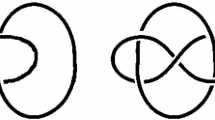Abstract
We consider an explicitly covariant formulation of the quantum field theory of the Maslov complex germ (semiclassical field theory) in the example of a scalar field. The main object in the theory is the “semiclassical bundle” whose base is the set of classical states and whose fibers are the spaces of states of the quantum theory in an external field. The respective semiclassical states occurring in the Maslov complex germ theory at a point and in the theory of Lagrangian manifolds with a complex germ are represented by points and surfaces in the semiclassical bundle space. We formulate semiclassical analogues of quantum field theory axioms and establish a relation between the covariant semiclassical theory and both the Hamiltonian formulation previously constructed and the axiomatic field theory constructions Schwinger sources, the Bogoliubov S-matrix, and the Lehmann-Symanzik-Zimmermann R-functions. We propose a new covariant formulation of classical field theory and a scheme of semiclassical quantization of fields that does not involve a postulated replacement of Poisson brackets with commutators.
Similar content being viewed by others
REFERENCES
V. P. Maslov, Operator Methods [in Russian], Nauka, Moscow (1973); English transl.: Operational Methods, Mir, Moscow (1976).
V. P. Maslov, Complex WKB Method in Nonlinear Equations [in Russian], Nauka, Moscow (1977); English transl.: Complex WKB Method for Nonlinear Equations: I. Linear Theory, Birkhauser, Basel (1994).
V. P. Maslov, Theorie des perturbations et methodes asymptotiques [in Russian], MSU, Moscow (1965); French transl., Dunod, Paris (1972).
V. G. Bagrov, V. V. Belov, and I. M. Ternov, Theor. Math. Phys., 50, 256 (1982).
V. P. Maslov and O. Yu. Shvedov, Complex Germ Method in the Many-Body Problem and in Quantum Field Theory [in Russian], URSS, Moscow (2000).
V. P. Maslov and O. Yu. Shvedov, Theor. Math. Phys., 114, 233 (1998).
O. Yu. Shvedov, J. Math. Phys., 43, 1809 (2002).
N. N. Bogoliubov, A. A. Logunov, A. I. Oksak, and I. T. Todorov, General Principles of Quantum Field Theory [in Russian], Nauka, Moscow (1987); English transl., Kluwer, Dordrecht (1990).
H. Lehmann, K. Symanzik, and W. Zimmermann, Nuovo Cimento, 6, 319 (1957); K. Nishijima, Phys. Rev., 119, 485 (1960).
N. N. Bogoliubov and D. V. Shirkov, Introduction to the Theory of Quantized Fields [in Russian] (4th ed.), Nauka, Moscow (1984); English transl. prev. ed., Wiley, New York (1980).
N. N. Bogoliubov, B. V. Medvedev, and M. K. Polivanov, Problems in the Theory of Dispersion Relations [in Russian], Fizmatgiz, Moscow (1958); English transl.: Theory of Dispersion Relations, Lawrence Radiation Laboratory, Berkeley, Calif. (1961); B. V. Medvedev, M. C. Polivanov, V. P. Pavlov, and A. D. Sukhanov, Theor. Math. Phys., 13, 939 (1972).
O. I. Zavialov, Renormalized Feynman Diagrams [in Russian], Nauka, Moscow (1979); English version: Renormalized Quantum Field Theory (Math. and Its Appl., Soviet Ser., Vol. 21), Kluwer, Dordrecht (1990).
A. A. Slavnov and L. D. Faddeev, Introduction to Quantum Theory of Gauge Fields [in Russian], Nauka, Moscow (1988); English transl.: L. D. Faddeev and A. A. Slavnov Gauge Fields: Introduction to Quantum Theory, Benjamin, London (1990).
J. Schwinger, Particles, Sources, and Fields, Vol. 2, Addison-Wesley, Reading, Mass. (1973).
O. Yu. Shvedov, Math. Notes, 65, 365 (1999); Sb. Math., 190, 1523 (1999).
O. Yu. Shvedov, Ann. Phys., 296, 51 (2002).
V. P. Maslov and O. Yu. Shvedov, Theor. Math. Phys., 104, 1141 (1995).
A. Ashtekar, J. Lewandowski, D. Marolf, J. Mourao, and T. Thiemann, J. Math. Phys., 36, 6456 (1995); D. Giulini and D. Marolf, Class. Q. Grav., 16, 2489 (1999); O. Yu. Shvedov, Ann. Phys., 302, 2 (2002).
O. Yu. Shvedov, Theor. Math. Phys., 136, 1258 (2003); hep-th/0111265 (2001).
R. Peierls, Proc. Roy. Soc. London A, 214, 143 (1952).
B. S. DeWitt, Dynamic Theory of Groups and Fields, Gordon and Breach, New York (1965); Phys. Rev., 162, No. 5 (1967); “A gauge invariant effective action,” in: Quantum Gravity 2 (C. J. Isham, R. Penrose, and D. W. Sciama, eds.), Clarendon, Oxford (1981).
D. Marolf, Ann. Phys., 236, 392 (1994).
O. Yu. Shvedov, “An axiomatic approach to semiclassical field perturbation theory,” hep-th/0412302 (2004).
Author information
Authors and Affiliations
Additional information
__________
Translated from Teoreticheskaya i Matematicheskaya Fizika, Vol. 144, No. 3, pp. 492–512, September, 2005.
Rights and permissions
About this article
Cite this article
Shvedov, O.Y. Relativistically Covariant Quantum Field Theory of the Maslov Complex Germ. Theor Math Phys 144, 1296–1314 (2005). https://doi.org/10.1007/s11232-005-0161-3
Received:
Revised:
Issue Date:
DOI: https://doi.org/10.1007/s11232-005-0161-3



